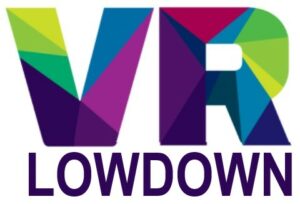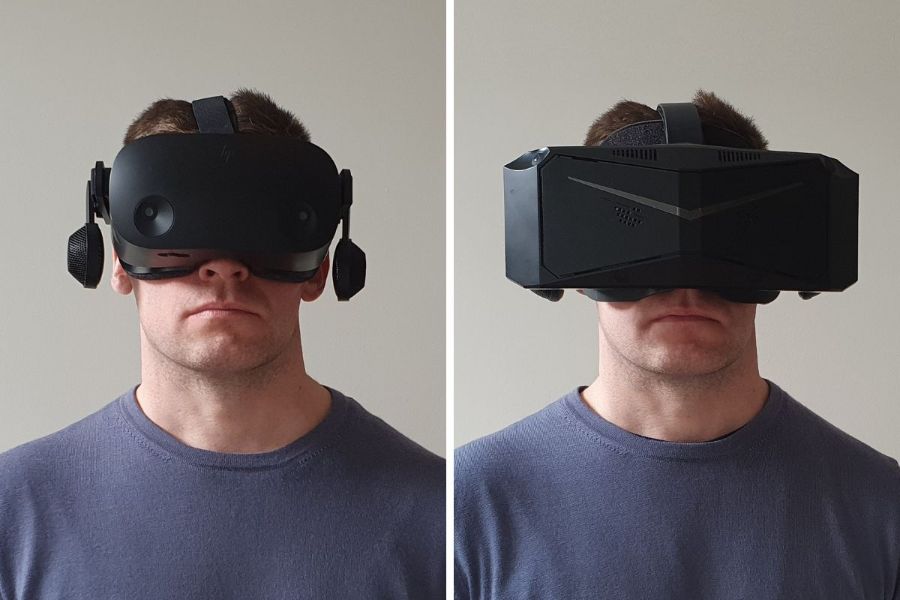
I’ve owned the HP Reverb G2 since it was released in 2020, and I’ve spent thousands of hours using it. I’ve also been using the Pimax Crystal extensively over the last 6 weeks, and the visual clarity on offer has blown me away. This article is going to compare the HP Reverb G2 vs Pimax Crystal to see how they stack up and help you decide which of these VR headsets is the better option for you.
The HP Reverb G2 has long been one of the most popular VR headsets for VR flight sim and racing sim enthusiasts thanks to the impressive visual clarity on offer. Although it’s been around since 2020, it still compares favorably to other options available. Coupled with the supreme comfort and attractive price point, I still think it is a great VR headset.
However, since the HP Reverb has been released, the competition has caught up, and there are a number of other headsets that offer better specs, although many of them cost considerably more. I’ve been using the Pimax Crystal headset extensively for the last 6 weeks, and I’ve generally been very impressed with it, particularly by the incredible visual clarity, which is the best I have seen in any headset so far.
The drawback is that the Pimax Crystal costs a lot more than the HP Reverb G2, so it needs to be a lot better to justify the higher price. I’m going to share my experience of using both headsets, discussing all the pros and cons, and how they stack up side by side.
I think both these headsets are great options for PCVR simulation enthusiasts as they both offer inside-out tracking, negating the need for an expensive and unnecessary tracking station setup. They both also prioritize clear visuals, which are crucial for both flight and racing simulation.
HP Reverb G2
There are many things I love about the HP Reverb G2. It has excellent lenses and display panels providing 2160×2160 pixels per eye resulting in clear visuals. It is lightweight and the facial interface is supremely comfortable, resulting in it being very comfortable to wear for extended sessions. The facial interface creates a perfect seal on my face, resulting in no light leak at all, and the audio from the off-ear speakers is really impressive.
Combined with a very attractive price point, the HP Reverb G2 remains a really good option for anyone looking for a great headset for PC VR content.
On the downside, the FOV is relatively narrow, being noticeably smaller than many other competing headsets, the lenses are quite prone to steaming up, and it’s tied to Windows Mixed Reality, which doesn’t bring much to the table.
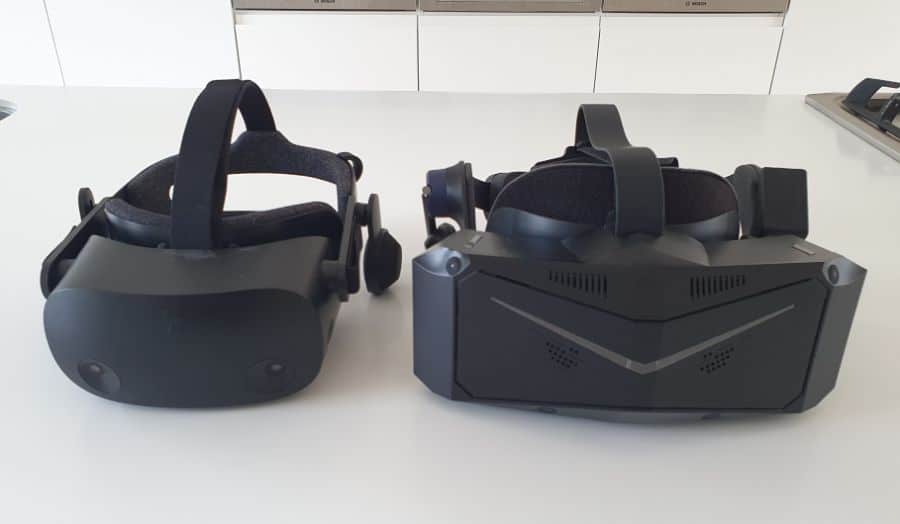
Pimax Crystal
The Pimax Crystal boasts glass aspheric lenses that are able to provide a 125-degree FOV, and QLED panels with a resolution of 2880 x 2880 per eye, providing the best visual clarity of any VR headset I have ever tried. This results in a peak clarity of 35 PPD, compared to 19 PPD for the HP Reverb G2. When I tried the Pimax Crystal for the first time, I was genuinely blown away by the visuals.
Although we’re still not close to the 60 PPD that is required to match 20/20 human vision, the increase in visual clarity makes a big difference to me when playing flight sims like DCS and Microsoft Flight Simulator. No more leaning forward to read cockpit instruments, or straining to see enemy aircraft in the distance.
In addition, it has eye tracking and dynamic foveated rendering, which allows the displayed resolution to adjust depending on gaze, reducing hardware load and improving performance. Eye tracking also allows automatic IPD detection and setting, which is a feature usually only seen on high-end VR headsets.
The downside to all of these features and visual clarity is that it costs more than twice the price of the HP Reverb G2, at $1600, although they do have a dedicated Crystal-Sim Limited Edition that drops the price to $1450 and comes without controllers. They are also offering an $800 trade-in deal for people who upgrade the Pimax Crystal to their upcoming Pimax 12K headset. You can purchase the Pimax Crystal from the Pimax website or from Amazon.
As a result of the uncompromising focus on visual clarity, the Pimax Crystal is a heavy and bulky headset. It weighs 960g and is quite front-heavy, so you do feel the weight when wearing it, particularly after using it for long periods. The headstrap and facial interface do a reasonable job of ensuring a comfortable fit, but it is nowhere near as comfortable to wear as the HP Reverb G2.
I can and do use the Pimax Crystal for hours at a time, and I never have to stop due to discomfort, but I definitely wish this could be improved.
The other drawback for PCVR sim fans is that the Pimax Crystal also has a standalone mode, necessitating a rear-mounted battery to be onboard at all times. This adds to the weight and complexity of the headset while providing minimal benefit for PCVR sim enthusiasts.
HP Reverb G2 Vs Pimax Crystal: Which Is Best?
Both of these headsets have a lot of excellent points, but also a number of drawbacks. As a result, the right headset for you will depend on your individual priorities. If you are looking for a good VR headset for PCVR use, that is particularly suited to VR flight and racing sims, the HP Reverb is still a great choice that you can safely buy and know that you are going to get many years of use and satisfaction from.
On the other hand, if you prioritize visual clarity, but are willing to pay the higher price, and put up with some drawbacks, then you will get immense pleasure from using the Pimax Crystal. If both headsets were the same price, I would tell everyone to go for the Pimax Crystal, even though it’s not a perfect headset. The price differential makes it a much more nuanced decision.
Let’s take a look at some of the key features of both the HP Reverb G2 and Pimax Crystal to see how they stack up in comparison.
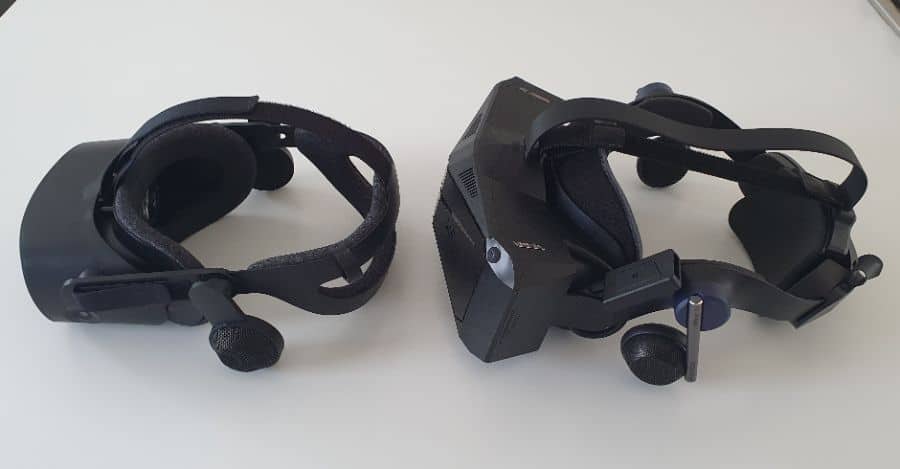
HP Reverb G2 and Pimax Crystal Specs
On paper, the specs of the Pimax Crystal beat the HP Reverb G2 in most areas, but you need to balance this with the negatives of the Pimax Crystal, in particular the weight and bulk of the headset, and the much higher price.
| Feature / Specification | Pimax Crystal | HP Reverb G2 |
|---|---|---|
| Display Type | Dual QLED + Mini-LED | Dual LCD |
| Resolution (per eye) | 2880 x 2880 | 2160 x 2160 |
| Total Resolution | 5760 x 2880 | 4320 x 2160 |
| Pixels Per Degree (approx) (PPD) | 35 | 19 |
| Lenses | Aspheric glass lenses | Plastic fresnel lenses |
| Refresh Rate (Hz) | 90/120 | 90 |
| Field of View (FOV) (Horizontal) | 125° | 98° |
| IPD Range (mm) | 58-72 (Manual and Automatic) | 60-68mm (Manual) |
| Audio | Off-ear stereo speakers (Optional DMAS) | Off-ear stereo speakers |
| Microphones | Integrated triple | Integrated dual |
| Tracking Type | Inside-out and SteamVR Tracking | Inside-out |
| Eye Tracking | Yes | No |
| Battery | 6000mAh Replaceable + 120mAh inside | N/A |
| Weight (g) | 960g including battery | 550g |
| Price | $1600 | $599 |
HP Reverb G2 Vs Pimax Crystal Video
In addition to this article, I’ve also made a video comparing these two headsets. I share my experience of using the HP Reverb G2 and the Pimax Crystal and discuss all the important features and how each headset performs in the real world.
Visuals
Both headsets have terrific visual clarity and they are a pleasure to use. The HP Reverb G2 was the undisputed king of clarity for quite some time after it was released, although it has now been surpassed by a number of other headsets. Whilst the Pimax Crystal has clearly superior visual clarity, better lenses and display panels, and a wider FOV, both headsets provide visuals that enhance the experience of VR, rather than detracting from it.
Neither headset has any discernable screen-door effect, but the HP Reverb G2 does have some god-rays as a consequence of using fresnel lenses, although these aren’t too distracting.
Although there appears to be a huge difference in the PPD between these headsets, I can definitely say that the level of clarity that the HP Reverb G2 provides is good enough for most people. If you are getting your first headset, or are not sure how much time you will spend using it, I would highly recommend opting for the HP Reverb G2.
I still put my HP Reverb G2 on after coming from the likes of the Quest 2, and I’m extremely impressed by the level of visual clarity. At this price point, it’s hard to think of a headset that will provide better visual clarity.
Despite the HP Reverb G2 having good visual clarity, the Pimax Crystal blows it out of the water in this department. The combination of glass aspheric lenses, QLED display panels with 2880 x 2880 resolution per eye, 125° FOV, and a large sweet spot provides visuals that are superior in every way. They allow me to see everything in the cockpit and in the distance when using flight simulators, which makes the whole experience much more immersive and satisfying.
This level of visual clarity isn’t strictly necessary to enjoy VR, and the improvement does come at a significant financial cost, but if you can afford it, the difference is very much worth it.
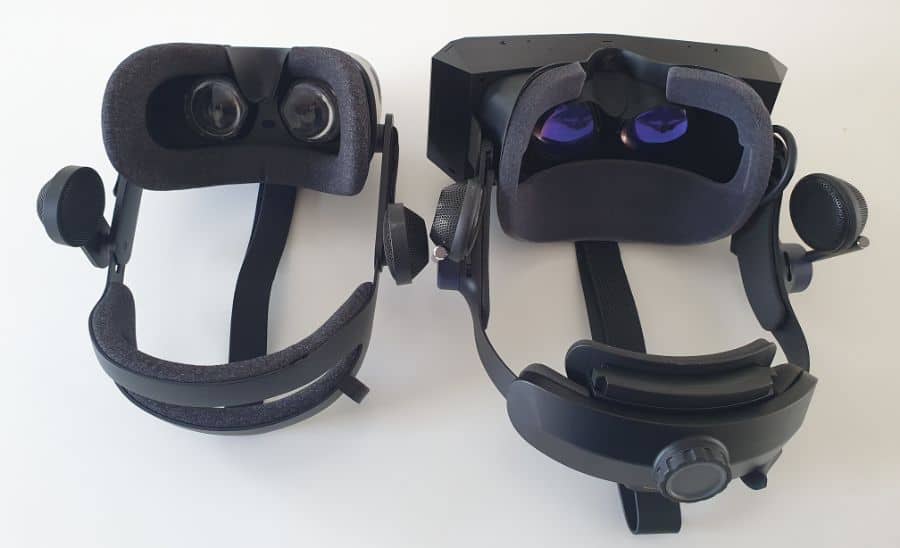
Field Of View And Sweet Spot
The HP Reverb G2 has a relatively narrow FOV of 98° horizontally, and this does restrict your view to some degree, compared to the 125° that the Pimax Crystal has. The limited FOV of the HP Reverb G2 is noticeable, but it is definitely something that you get used to over time, and it stops being a significant issue pretty quickly.
As you spend the majority of your time with your eyes focused on the center of the lenses, the narrower FOV of the HP Reverb G2 isn’t excessively restrictive. However, a wider FOV is more immersive and helps you to feel like you are physically in the cockpit of a plane or in the seat of a racing car.
The HP Reverb G2 has a relatively small sweet spot in the center of the lenses where everything is perfectly clear, and you do need to ensure the headset is positioned correctly on your head. If you let your gaze move from the center of the lenses, the visual clarity drops off quickly, and text legibility and visual clarity decrease significantly.
As a result, you will find yourself keeping your eyes looking forward and moving your head to look around in an effort to maintain high clarity. Whilst this isn’t a very natural movement, it isn’t a particular burden and something you adapt to quickly out of necessity.
Although the Pimax Crystal has a much larger sweet spot, it does require you to carefully position the headset to ensure that your eyes are in the center of the lenses. If you don’t do this, you will experience barrel distortion of the image through the aspheric lenses. You can avoid this by ensuring the headset is positioned carefully and that the headstrap is tightened sufficiently to prevent movement of the headset while in use.
As long as you put your Pimax Crystal on correctly, you can gaze around with your eyes, and the image that you see will remain very clear for a considerable portion of your vision. This feels much more natural and enjoyable to use.
Comfort
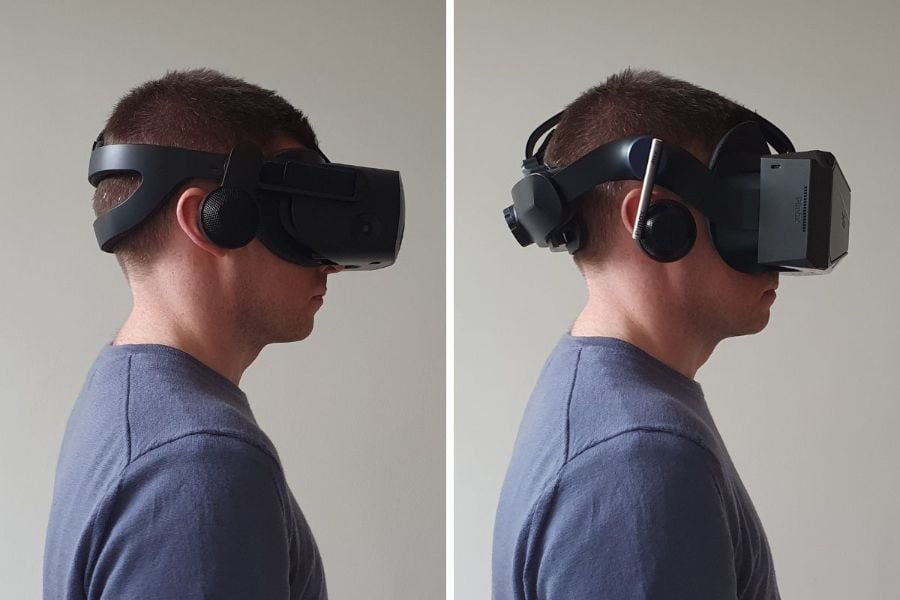
The HP Reverb G2 is undoubtedly the most comfortable VR headset I have ever used, and three years on, I still haven’t used a more comfortable headset. It fits perfectly on my face, the padding feels great, and there is no light leak at all.
I love the design of the headstrap on the HP Reverb G2. The flip-up design means that you don’t need to adjust the fit each time you put it on. You just hold the face gasket up to your face, ensure it is positioned correctly, and pull the headstrap down over the back of your head, making it easy to take on and off in a second.
One negative implication of the snug fit is that the lenses on the HP Reverb G2 have a tendency to steam up during the first few minutes of use when the lenses are cold, causing condensation to form from the warm, humidified air around your face.
This is less of an issue for seated VR, but anything more energetic usually results in me having to wipe the lenses after the first few minutes. Once the lenses warm up, they stop steaming up, so I often wait a few minutes after turning the headset on before starting to use it to minimize this issue.
Pimax Crystal is a more difficult headset to achieve a comfortable fit, and part of this is due to it being quite front-heavy and bulky. I can achieve a reasonably comfortable fit, but it requires me to be more precise with positioning the headset on my face, pulling the headstrap down over the back of my head, and then tightening it firmly with one hand while holding it in position on my face with the other.
Due to the bulk and weight of the headset, it’s important to keep the headstrap quite tight to prevent it from wobbling around on your face when you turn your head. This results in me usually wearing the Pimax Crystal a little more tightly than would be ideal. The facial interface material is soft and comfortable, but the overall comfort level is just OK.
You will need to adjust the headstrap of the Pimax Crystal every time you put it on and off, and as there is no passthrough mode, this does make it a bit annoying when you have to take the headset off just to press a few buttons on your keyboard, only to have to go through the process of readjusting it again.
Controllers And Tracking
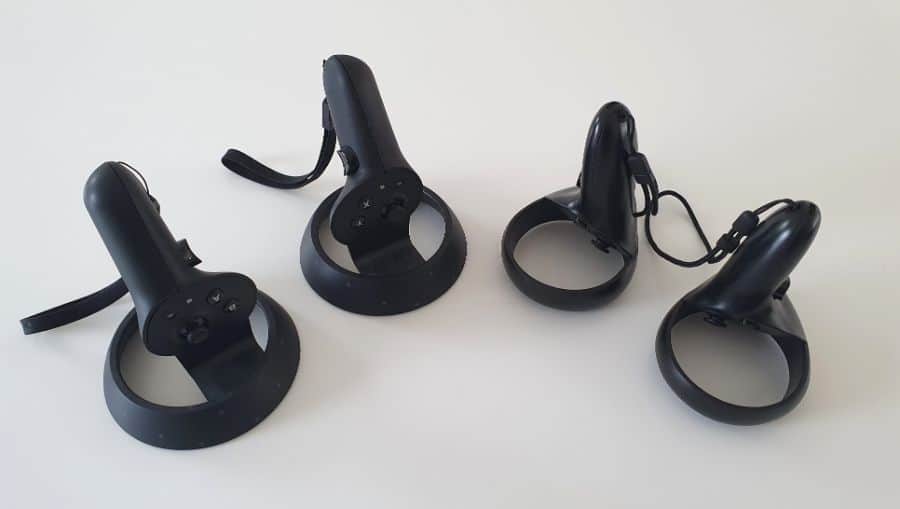
Both the HP Reverb G2 and Pimax Crystal use inside-out tracking, and both headsets have four cameras positioned on the headset to track the movement of the controllers. When each headset was released, there were some issues with controller tracking that impacted performance, but both have improved considerably. The HP Reverb G2 has seen significant improvements to its controller tracking over the last three years, and I feel it offers excellent performance.
When I first received my Pimax Crystal, the controller tracking was excellent when I kept my hands in front of the headset, but was very poor when I had to move or swing the controllers above my head or behind my back. I commented on how disappointing this was in my initial review.
Thankfully, there have been a number of updates to the software over the last few weeks, and I have noticed a dramatic improvement in controller tracking performance. I now feel that the controller tracking is of a very similar standard on both headsets.
Interestingly, the Pimax Crystal has an optional Lighthouse Tracking Faceplate accessory that you can purchase that allows you to use external tracking stations. I haven’t tried this, but it is great to have this option, for people who already have, or really want to use external tracking with this headset.
I typically try games like Eleven Table Tennis, Premium Bowling, and Beat Saber to test controller tracking due to the fast controller movements required and wide range of motion. I don’t think you will have any issues with either headset in terms of tracking, within the limitations of current inside-out tracking technology.
In terms of controller design, the HP Reverb controllers are starting to look quite dated. They are much more bulky and less ergonomic than the Pimax Crystal controllers and don’t really stand up to the controller design of most VR headsets that have been released in the last two years.
Having said that, they still work well, and I am happy to use them. The menu buttons are positioned a little too conveniently to be pressed inadvertently with the base of your thumb, and I have ended up on the menu screen unexpectedly numerous times when playing vigorous games such as Thrill Of The Fight.
The Pimax Crystal controllers look and feel like Quest 2 controller clones, although they have an integrated battery, and feel much lighter to hold. The build quality is pretty good, and overall, I enjoy using them.
Setup And Performance
Setting up and using the HP Reverb G2 is easy, with just a few steps to install it and calibrate your room. HP Reverb G2 is tied to the Windows Mixed Reality ecosystem, which is a bit of an inconvenience, as it isn’t widely used.
Whenever you start the headset, you enter the Windows Mixed Reality home environment. I just minimize this window on my desktop and then launch Windows Mixed Reality for SteamVR to enter the SteamVR home environment to play all my SteamVR content. I also play a lot of DCS World with my HP Reverb G2 and I simply launch DCS and it loads directly into VR mode.
Overall, the HP Reverb G2 is an easy headset to work with, and I’ve had minimal technical issues. There were quite a few teething problems when it first launched, but things have been rock solid over the last year. It takes me less than a minute to switch my headset on and start playing whatever experience I want.
Pimax Crystal is launched via their Pimax Play software that you download and install on your computer. All I do to start using it is launch the Pimax Play software, turn on my headset, click the Launch Steam VR button, and then put my headset on.
It has worked flawlessly for me since I got the headset six weeks ago and makes the process of playing VR content on Pimax Crystal very simple and easy. I’m aware that some users experienced some technical issues when Pimax Crystal was first launched, but I think I believe most of these have been ironed out, and I certainly haven’t had any major issues.
Pimax does have a habit of launching headsets and software as soon as they can, often at the expense of polishing any rough edges, and I don’t think this is a very good strategy on their part, as it often gives people a negative first impression of their headsets. It would be much better to hold off launching new headsets or software until the vast majority of issues are resolved.
Sound Performance Of Pimax Crystal And HP Reverb G2
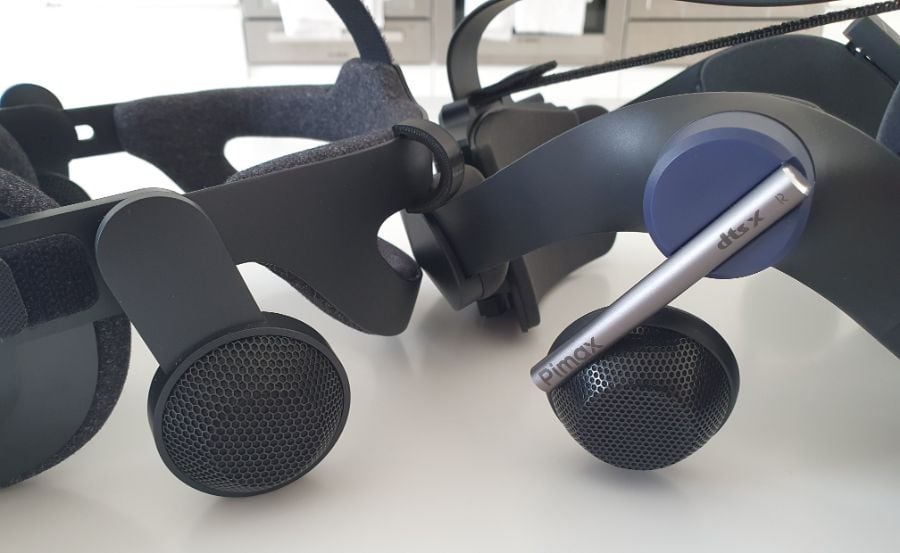
Both the HP Reverb G2 and Pimax Crystal use off-ear speakers and I’ve been impressed with the sound quality of both. I think the Valve Index was the first VR headset to use this type of audio solution, and it offers a lot of benefits.
Both headsets allow you to position the speakers right over your ears and I have generally found the audio quality to be impressive. I’m certainly not an audiophile, and some people feel that having the option to use your own headphones is better, but for most people, this solution is convenient and performs well. I honestly couldn’t pick which headset provides better audio, as they offer very similar performance.
Value
The headset that you ultimately end up choosing will depend on the amount of value that you will get from each one. I think it boils down to something quite simple. If you want a solid PC VR headset that will provide great performance, without having to spend a fortune, the HP Reverb G2 is an excellent option, even as of when I am writing this article, towards the end of 2023.
If you’re keeping an eye on your budget, or if you are not already a hardcore VR flight simmer, the HP Reverb G2 is the better headset to choose. You can easily use and enjoy it for the next few years, and then upgrade in a few years when both of these headsets will have been surpassed by newer technology.
However, if you are already a dedicated flight or racing sim enthusiast and you’re looking for the best VR headset for seated PC VR experiences, then you can’t really do better than the Pimax Crystal. It comes with a few compromises and drawbacks, but the immersion and visual clarity that you experience with the Pimax Crystal is totally worth it.
The Pimax Crystal is expensive, but so is a high-end monitor, or even a triple monitor setup, and buying flight and racing controllers and other accessories is expensive too. If you’re willing to pay the money for the best visual clarity you can get in a VR headset today, then the Pimax Crystal is a great headset to choose.
HP Reverb G2 Vs Pimax Crystal Pros And Cons
| Pros Of Pimax Crystal | Cons Of Pimax Crystal |
| The best visual clarity you can get in a VR headset | Heavy and front-weighted |
| Large sweet spot and good FOV | Bulky |
| Easy setup and hassle-free use | Expensive |
| Optional lighthouse tracking | Not as comfortable as it should be |
| $800 trade-in value if you wish to upgrade to Pimax 12K when it is released | Standalone mode and integrated battery unnecessary for most. |
| Pros Of HP Reverb G2 | Cons Of HP Reverb G2 |
| Good visual clarity | Small sweet spot |
| Very comfortable | Relatively small FOV |
| Easy to put on and remove headset | Controllers feel outdated |
| Excellent value considering features | Tied to Windows Mixed Reality |
| Large userbase of PCVR sim enthusiasts | Lenses are prone to steaming up |
